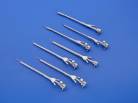News
-
 06.12.2010/ Movement Driven Vision - A Concept for Endoscopic Microsurgery acc. to ALENCASTRO
06.12.2010/ Movement Driven Vision - A Concept for Endoscopic Microsurgery acc. to ALENCASTRO
Movement Driven Vision – A concept for endoscopic microsurgery acc. to ALENCASTRO
The ability of endoscopes to bring excellent illumination and enhanced visualization into areas of interest leads to the possibility of working in body cavities through reduced access and therefore reduced trauma. To manage solid lesions inside solid tissue, the creation of a cavity is necessary - a trajectory where light, vision and surgical tools come to the working site. In treating intraparenchymal brain lesions, the site and size of this cavity is critical.
Coupling a dissecting or suction tool to a scope gives the ability to deal with intracerebral lesions through very narrow corridors allowing standard bimanual microsurgical techniques. In this way, the vision follows the movement where it is needed, as the scope is attached to the dissection or suction tool.
This concept for “Movement Driven Vision” includes different sheaths that cover the optical rod and composes vision, illumination and surgical tool. With integrated angled dissectors and suction tubes, these sheaths are not only standard operating sheaths. The sheaths provide suction and irrigation at the distal tip of the scope in order to keep the lens clean. Various tips give the opportunity to elect the most appropriate instrument for each surgical demand. These operating sheaths are designed to work with 0° and 30° scopes.
Brain tumors, cavernomas, intraparenchymatous hematomas and ischemic brain lesions are among the lesions that can be managed by this technique, while encephalic structures are preserved maximally.
Field of Application: Endoscopic intracranial surgery




 Integrated theatres, Endoscopic camera systems, Endoscopic units, Telescopes and Instruments for all disciplines
Integrated theatres, Endoscopic camera systems, Endoscopic units, Telescopes and Instruments for all disciplines
 Patient Warming Blankets and Temperature Management Systems
Patient Warming Blankets and Temperature Management Systems
 Portering Chairs, I.V Poles, Examination Couches, Surgeons Stools
Portering Chairs, I.V Poles, Examination Couches, Surgeons Stools
 Laundry Carts, Bulk Transport Carts, Catering Trolleys, CSSD Tables, Racking and Equipment
Laundry Carts, Bulk Transport Carts, Catering Trolleys, CSSD Tables, Racking and Equipment

